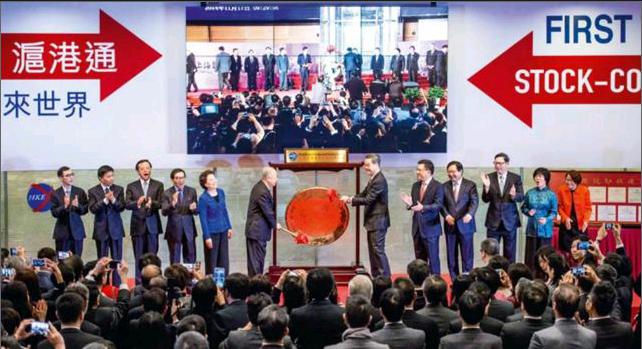A Two-Horned Bull
by+Liu+Yonggang

November 17, 2014 was a big day for Chinas capital market: the Shanghai-Hong Kong Stock Connect, also known as the “through train” or Hu-Gang Tong, was officially launched after seven years of painstaking preparations. On the very day of opening, investors from Chinas mainland purchased 1.768 billion yuan of H-shares, while those from Hong Kong bought 13 billion yuan of A-shares – the daily limit, which sold out at 1:53 p.m.
The securities-trading link is not new to either mainland or Hong Kong investors because the same pilot mode stimulated the market in Hong Kong seven years ago. Today, the program has become functional thanks to joint efforts of many to accelerate the pace of RMBs internationalization.
Mapping
In early 2007, managers of Tianjin Binhai New Area and Bank of China(BOC) International together designed a prototype of the program, enabling individuals to purchase foreign currency and invest in Hong Kongs stock market through BOC International, thus allowing the Tianjin Branch of BOC to sell foreign currency while BOC International earned a transaction fee.
“The municipal government of Tianjian appreciated the idea, and more support was soon received from relevant state authorities,” recalls Xiao Gang, former BOC president and present chairman of the China Securities Regulatory Commission(CSRC). On August 20, 2007, Chinas State Administration of Foreign Exchange issued a pilot plan for individuals on Chinese mainland to directly invest stock markets overseas, allowing mainland investors to open an account with BOCs branch in Tianjin to buy stocks listed on Hong Kong Exchanges.
Nevertheless, the pilot plan failed to acquire approval from securities supervisory authorities. In October 2007, Zhou Xiaochuan, president of BOC, declared that the plan could not begin operation without testing.
In 2007, the government of the Hong Kong Special Administrative Region launched the pilot campaign of Qualified Domestic Institutional Investor (QDII) on the mainland, which proved effective. Therefore, between 2011 and 2012, the Hong Kong Chinese Securities Association and many regional supervision authorities proposed QDII2, suggesting allowing individual investors of high net worth from the mainland to invest in H-shares using the quota of QDII. Still, neither investors nor the market were satisfied with QDII and QDII2.
Not until two years ago did the Shanghai Stock Exchange reach an agreement with managers of the Hong Kong Exchanges to launch the Hu-Gang Tong, after researching financial reform focused on RMB internationalization. The plan was hatched in a corner of Shenzhen, Guangdong Province.
In 2012, in a small teahouse in Shenzhen, Charles Li, president of the Hong Kong Exchanges, met Gui Minjie and Huang Hongyuan, president and general manager, respectively, of Shanghai Stock Exchange, to map out a system to connect stock exchanges in Shanghai and Hong Kong. Both sides worked to understand the situation from the opposite perspective and introduce novel ideas. “It wasnt very smooth,” remarks Gui,“But we eventually managed to slowly shrink the gap between us.”
The differences between the respective markets in Shanghai and Hong Kong are many in terms of structure, transaction system, regulation and supervision, which proved a daunting challenge when constructing a system of interconnection. For example, even the transaction currency –RMB in Shanghai and Hong Kong dollars in Hong Kong – made pricing and settlement of simultaneous deals difficult.
According to General Manager Huang Hongyuan, a principle of combining home court advantages and investors habits was employed in designing the program. Normally, investors in either Hong Kong or Shanghai can play by local rules, but when buying through Hu-Gang Tong, they must follow the rules of the opposite side.
When it comes to currency, A-share brokers from Hong Kong make direct quotes in CNY while H-share brokers from the mainland still use CNY for quotes but trade in Hong Kong dollars. The system will automatically clear accounts by converting CNY into HKD.
As for contrasting market rules, a minimum requirement was set in the new mechanism to qualify investors from the mainland: they must start with at least 500,000 yuan of stock value. “Theres no minimum to buy on the Hong Kong market,” explains Dai Wenhua, general manager of the China Securities Depository and Clearing Corporation Limited. “The minimum was set to protect investors from the mainland.”
“We made our plan reality,” grinned Charles Li. The innovative mechanism of the Shanghai-Hong Kong Stock Connect set a good model for linking two different stock exchanges in many ways thanks to unremitting efforts from both sides.
Missions of Securities Regulatory Authorities
The night before the Shanghai-Hong Kong Stock Connect went live, Charles Li described the pilot transaction between Shanghai and Hong Kong as a “roundtrip starter train” for the capital market in China and attributed the connect to two“unsung heroes” – CSRC and Securities& Futures Commission, which hastened the launch and built a bridge for financial exchange between the two.
In April 10, 2014, CSRC and Securities & Futures Commission promulgated a joint announcement, approving in principle the pilot cross-border investment scheme. Since then, the two authorities have conducted practical preparation with regards to the regulatory system, operational program, supervision and control, investor education and overseas marketing, technological development, and testing, in collaboration with stock exchanges in Shanghai and Hong Kong as well as clearing institutions from both sides.
On October 17, 2014, CSRC and Securities and Futures Commission jointly signed a Memorandum of Understanding to enhance supervision and regulatory enforcement of the Shanghai-Hong Kong Stock Connect by the two authorities, completing the arrangement for a system of cross-border supervision and cooperation for the scheme.
On the eve of November 14, just before operation began, three departments, including Chinas Ministry of Finance, jointly released privilege policies on taxation: All H-share investors from the mainland enjoy a three-year exemption of individual income tax on all capital gains.
At the launch ceremony in Shanghai, CSRC chairman Xiao Gang noted that the Shanghai-Hong Kong Stock Connect has created a new model for cross-border portfolio investment featuring convenient operation and controllable risk under the circumstance that capital projects in China havent realized conversion. It marks significant innovation for capital market mechanisms in the country.
Actually, for a long time, the Central Government has enacted a series of policies and measures to strengthen cooperation between the mainland and Hong Kong, aiming at benefitting Hong Kong.
In terms of financial cooperation, in 2012, the Central Government announced ideas to provide access to Hong Kongs long-term capital market on the mainland, establish a joint venture between Shanghai and Hong Kong exchanges, found cross-border exchange funds, allow trade investment and settlement in RMB in Hong Kong by third parties, and accelerate financial cooperation between Guangdong Province and Hong Kong.
As pointed out by Charles Li, “The true engine of the ‘through train is the spike caused by the introduction of a huge sum of capital to the capital markets of both Shanghai and Hong Kong through tremendous fusion which will enhance both markets rather than just re-distributing stocks on both sides.”

